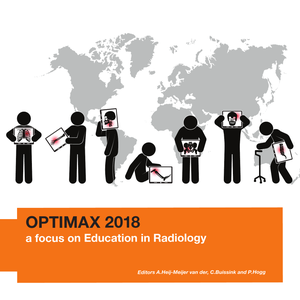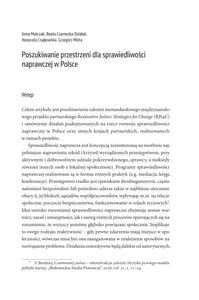This article addresses drivers and partner features in vertical or horizontal cooperation. A survey is used to assess their impact and to evaluate whether respondents give significantly different scores to comparable influencing factors depending on the type of cooperation. The results show that internal stakeholder support and investments needed for collaboration turn out to be more critical in the case of horizontal collaboration. Innovation potential of the partner features and the fit between the cooperating organizations are judged as more important partner features in the case of horizontal cooperation.
DOCUMENT
Background: A large number of people participate in individual or unorganized sports on a recreational level. Furthermore, many participants drop out because of injury or lowered motivation. Potentially, physical activity–related apps could motivate people during sport participation and help them to follow and maintain a healthy active lifestyle. It remains unclear what the quality of running, cycling, and walking apps is and how it can be assessed. Quality of these apps was defined as having a positive influence on participation in recreational sports. This information will show which features need to be assessed when rating physical activity–related app quality. Objective: The aim of this study was to identify expert perception on which features are important for the effectiveness of physical activity–related apps for participation in individual, recreational sports. Methods: Data were gathered via an expert panel approach using the nominal group technique. Two expert panels were organized to identify and rank app features relevant for sport participation. Experts were researchers or professionals in the field of industrial design and information technology (technology expert panel) and in the field of behavior change, health, and human movement sciences who had affinity with physical activity–related apps (health science expert panel). Of the 24 experts who were approached, 11 (46%) agreed to participate. Each panel session consisted of three consultation rounds. The 10 most important features per expert were collected. We calculated the frequency of the top 10 features and the mean importance score per feature (0-100). The sessions were taped and transcribed verbatim; a thematic analysis was conducted on the qualitative data. Results: In the technology expert panel, applied feedback and feedforward (91.3) and fun (91.3) were found most important (scale 0-100). Together with flexibility and look and feel, these features were mentioned most often (all n=4 [number of experts]; importance scores=41.3 and 43.8, respectively). The experts in the health science expert panels a and b found instructional feedback (95.0), motivating or challenging (95.0), peer rating and use (92.0), motivating feedback (91.3), and monitoring or statistics (91.0) most important. Most often ranked features were monitoring or statistics, motivating feedback, works good technically, tailoring starting point, fun, usability anticipating or context awareness, and privacy (all n=3-4 [number of experts]; importance scores=16.7-95.0). The qualitative analysis resulted in four overarching themes: (1) combination behavior change, technical, and design features needed; (2) extended feedback and tailoring is advised; (3) theoretical or evidence base as standard; and (4) entry requirements related to app use. Conclusions: The results show that a variety of features, including design, technical, and behavior change, are considered important for the effectiveness of physical activity–related apps by experts from different fields of expertise. These insights may assist in the development of an improved app rating scale.
LINK
The sharing economy holds promise for the way we consume, work, and interact. However, consuming in the sharing economy is not without risk, as institutional trust measures (e.g. contracts, regulations, guarantees) are often absent. Trust between sellers and buyers is therefore crucial to complete transactions successfully. From a buyer ́s perspective, a seller ́s profile is an important source of information for judging trustworthiness, because it contains multiple trust cues such as a reputation score, a profile picture, and a textual self-description. The effect of a seller’s self-description on perceived trustworthiness is still poorly understood. We examine how the linguistic features of a seller’s self-description predict perceived trustworthiness. To determine the perceived trustworthiness of 259 profiles, 189 real buyers on a Dutch sharing platform rated their trustworthiness. The results show that profiles were perceived as more trustworthy if they contained more words (which could be an indicator of uncertainty reduction), more words related to cooking (indicator of expertise), and more words related to positive emotions (indicator of enthusiasm). Also, a profile’s perceived trustworthiness score correlated positively with the seller’s actual sales performance. These findings indicate that a seller’s self-description is a relevant signal to buyers, eventhough it is cheap talk (i.e. easy to produce). The results can guide sellers on how to self-present themselves on sharing platforms and inform platform owners on how to design their platform so that it enhances trust between platform users.
DOCUMENT
The aim of this study was to identify expert perception on which features are important for the effectiveness of physical activity–related apps for participation in individual, recreational sports. This study was part of a research project 'For everyone an app?!'.
DOCUMENT

Purpose – Information verification is an important factor in commercial valuation practice.Valuers use their professional autonomy to decide on the level of verification required, thereby creating an opportunity for client-related judgement bias in valuation. The purpose of this paper is to assess the manifestation of client attachment risks in information verification. Design/methodology/approach – A case-based questionnaire was used to retrieve data from 290 commercial valuation professionals in the Netherlands, providing a 15 per cent response rate of the Dutch commercial valuation population. Descriptive and inferential statistics have been used to test research hypotheses involving relations between information verification and professional features that may indicate client attachment such as an executive job level and brokerage experience. Findings – The results reveal that valuers acting at partner level within their organisation obtain lower scores on information verification compared to lower-ranked valuers. Also, brokerage experience correlates negatively to information verification of valuation professionals. Both findings have statistical significance. Research limitations/implications – The results reflect valuers’ reasoning behaviour rather than actual behaviour. Replication of findings through experimental design will contribute to research validity. Practical implications – Maintaining close client contact in a competitive environment is important for business continuity yet may foster client attachment.The associated downside risks in valuation practice call for higher awareness of (subconscious) client influence and the development of attitudinal scepticism in valuer training programmes. Originality/value – This paper is one of the few that explore possible sources of valuer judgement bias by relating client-friendly valuer features to a key area of valuation i.e. information verification.
LINK
This year, OPTIMAX was warmly welcomed by University College Dublin. For the sixth time students and teachers from Europe, South Africa, South America and Canada have come together enthusiastically to do research in the Radiography domain. As in previous years, there were several research groups consisting of PhD-, MSc- and BSc students and tutors from the OPTIMAX partner Universities or on invitation by partner Universities. OPTIMAX 2018 was partly funded by the partner Universities and partly by the participants.
DOCUMENT

This chapter discusses the following keywords for learning outcomes for Collaborative Online International Learning (COIL). 1. Clarity: Knowing what you want your students to achieve. 2. Shared: Designed together with your partner to match your course content. 3. Aligned: Linking different components (outcomes, assessment, and activities) of your COIL project together.
DOCUMENT

Thank you for sharing this story! However, please do so in a way that respects the copyright of this text. If you want to share or reproduce this full text, please ask permission from Innovation Origins (partners@innovationorigins.com) or become a partner of ours! You are of course free to quote this story with source citation. Would you like to share this article in another way? Then use this link to the article: https://innovationorigins.com/en/silicon-sampling-ai-powered-personas-offer-new-insights-for-market-research-but-have-limitations/ n the rapidly evolving field of marketing and communication, staying ahead means embracing technological innovations. The latest breakthrough, silicon sampling, leverages AI to revolutionize market research by creating synthetic personas that mimic human responses. This method, which utilizes large language models (LLMs) like GPT-4o, offers a cost-efficient and less time-consuming alternative to traditional market research. Roberta Vaznyte and Marieke van Vliet (Fontys University of Applied Science) have explored the promise and challenges of silicon sampling, highlighting key findings from recent experiments and the implications for the future of market research.
LINK
A comparative study of the effects of the pandemic across six countries, including The UK, Australia, Belgium, Cyprus, Ireland and The Netherlands. The authors outline 21 design principles for mobile learning, which is hoped will help us respond effectively in the uncertain present, and plan systematically for an unpredictable, post-pandemic future. This paper is based on the emergency changes we have had to make in the European DEIMP Project (2017-2020), “Designing and Evaluating Innovative Mobile Pedagogies” (DEIMP). DEIMP is undertaken by a transnational consortium comprising partner institutions and schools from the participating countries.
MULTIFILE

The aim of this article is to present the objectives of a customised international partnership project Restorative Justice: Strategies for Change (RJS4C) project, and discuss activities undertaken for the development of restorative justice in Poland and other partner countries.
MULTIFILE
